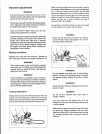
I
29
WARNING!
There is an extreme danger of kickback at this
point. Extra caution must be taken to maintain
control of the saw.
To
make the felling cut, follow
the sectioning method described previously (fig.
29).
If
you are inexperienced with a chain saw
plunge-cutting should not be attempted. Seek the
help of a professional.
Limbing
Limbing is removing the branches fiom a fallen tree.
WARNING!
There is an extreme danger of kickback during the
limbing operation.
Do
not work with the nose of the
bar. Be extremely cautious and avoid contacting
the log or other limbs with the nose of the guide bar.
Do
not stand on a log while limbing it
-
you may slip
or the log may roll.
Start limbing by leaving the lower limbs to support
the log
off
the ground (fig. 30). Always cut from the
top of the limb.
Do
not underbuck freely hanging
limbs. A pinch may result or the limb may fall,
causing
loss
of control. If a pinch occurs, stop the
engine and remove the saw, by lifting the limb.
WARN
I
NG!
Be extremely cautious when cutting limbs under
tension. The limbs could spring back toward the
operator and cause
loss
of control of the saw or
injury to the operator.
Bucking
Bucking
is
cutting
a
log
into
sections.
31 31
WARN
I
NG!
1.
When bucking, do not stand on the log. Make
sure the log will not roll down-hill. If
on
a slope,
stand on the up-hill side of the log (see fig. 31).
Watch out for rolling logs.
WARNING!
2. Cut only one log at a time.
WARNING!
3. Shattered wood should be cut very carefully.
Sharp slivers of wood may be caught and flung
in the direction of the operator of the saw.
32
WARNING!
4.
When cutting small logs, use a sawhorse (fig.
32). Never permit another person to hold the
log. Never hold the log with your leg or foot.
14


















